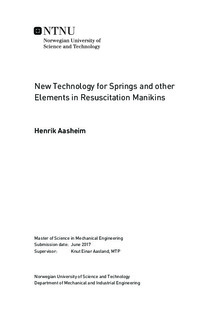New Technology for Springs and other Elements in Resuscitation Manikins
Abstract
This master thesis identifies needs for an improved infant CPR manikin through an anatomic study, user empathy and gained knowledge about leading CPR guidelines. The knowledge obtained by needfinding resulted in three possible improvements of the chest compression mechanism, these are:
Compression mechanism which allows room for implementation of advanced airway management Progressive chest stiffness, which is more realisticSimulate breaking of ribs
Different technologies, not yet used in training manikins are explored. The possibilities and limitations of these technologies are revealed and evaluated. The most promising technologies are: -Air spring -Force regulated linear actuator -A thin polymer sheet representing the rib cage
The air spring provides a more realistic chest stiffness and is also less space consuming than the current solution. This enables the possibility of implementing an advanced airway.
The force regulated linear actuator concept does not enable more room for an advanced airway. However, it does make it possible to apply any chest characteristic obtained by patient measurements. Moreover, it enables the possibility of simulating breaking of ribs during chest compression, as the stiffness is regulated by software.
The polymer plate concept consumes very little space, thus allowing room for implementation of advanced airway management functionality. Considerable effort is made to verify if this solution will have the desired lifetime by applying mechanics of materials theory and finite element analysis. However, more testing is required to obtain a desired result.
